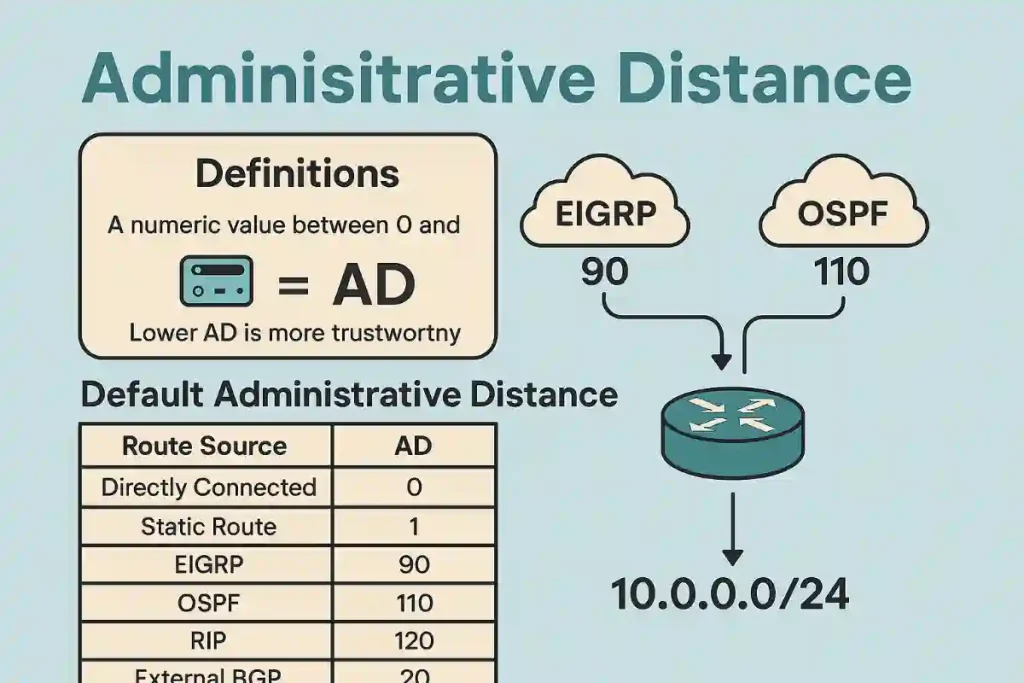In network environments, routers often receive multiple routes to the same destination from different sources, such as routing protocols (e.g., OSPF, EIGRP, RIP), static routes, or directly connected networks. To select the most trustworthy route, Cisco routers use Administrative Distance (AD), a critical concept in the Cisco Certified Network Associate (CCNA) curriculum. This article explains AD’s purpose, default values, and practical applications.
Note:- At the end of this article, the assessment test is waiting for you about the Administrative Distance
What is Administrative Distance (AD)?
Administrative Distance (AD) is a numeric value between 0 and 255 that routers use to evaluate the reliability of a routing information source. The lower the AD value, the more trustworthy the source. When multiple routes to the same network exist, the router compares their ADs and selects the route with the lowest AD. Only if ADs are equal does the router use metrics (e.g., hop count, cost) to choose the best path.
For example, if the routing table has more than one route source for the same destination network, a router configured for that network will use both Enhanced Interior Gateway Routing Protocol (EIGRP) and Routing Information Protocol (RIP).
So, both routing protocols may decide on a different path to the destination based on that routing protocol’s metrics because RIP selects a path based on hop count, and EIGRP selects a path based on its composite metric. So, the administrator distance is the value that tells the router which path is best and which path to use first.
As I initially asked, it is a numeric value ranging from 0 to 255. A smaller AD value is more reliable and trustworthy. Therefore, the best AD value is 0, and the worst is 255. The static route AD is 1, whereas the AD of EIGRP is 110, so the static route is more reliable and trustworthy.
When there are static and EIGRP routes to the same destination, the router chooses the static route because it has the lowest AD value.
If EIGRP and OSPF are configured to the same destination, the router will choose EIGRP because the AD of EIGRP is 90 and OSPF’s is 110. So, the router will determine the route with the lowest value, EIGRP its AD, and OSPF’s.
Default Administrative Distance Values
The table below illustrates the default router administrative distance values. We can change and modify the administrative distance of a routing protocol through the distance command in the routing sub-configuration mode. However, modifying the AD value can lead to routing loops and black holes, so use caution if you change it.
Below are Cisco’s default AD values for familiar route sources:
| Route Source | Default AD |
|---|---|
| Directly Connected Interface | 0 |
| Static Route | 1 |
| Enhanced Interior Gateway Routing Protocol (EIGRP) Summary Route | 5 |
| External Border Gateway Protocol (eBGP) | 20 |
| Internal EIGRP | 90 |
| Open Shortest Path First (OSPF) | 110 |
| Intermediate System-to-Intermediate System (IS-IS) | 115 |
| Routing Information Protocol (RIP) | 120 |
| External EIGRP | 170 |
| Internal BGP (iBGP) | 200 |
Key Notes:
- Directly connected networks (AD 0) are always preferred.
- Static routes (AD 1) override dynamically learned routes unless their AD is manually increased.
- EIGRP has separate ADs for internal (90) and external (170) routes.
How Administrative Distance Works: Examples
Example 1: Static Route vs. OSPF
A router receives a route to 10.0.0.0/24 via:
- A static route (AD = 1).
- OSPF (AD = 110).
Result: The static route is preferred due to its lower AD.
Example 2: RIP vs. EIGRP
A router learns about 192.168.1.0/24 through:
- RIP (AD = 120).
- EIGRP (AD = 90).
Result: EIGRP’s route is chosen because of its lower AD.
Administrative Distance vs. Metric
It’s crucial to distinguish between AD and metric:
- AD determines trustworthiness between different routing sources.
- Metric determines the best path within the same routing protocol.
For example:
- Two OSPF routes to the exact network use cost (metric) to decide the best path.
- An OSPF route (AD 110) will always be preferred over a RIP route (AD 120), even if the RIP route has a better metric (e.g., fewer hops).
Configuring Administrative Distance
Administrators can modify AD values for flexibility.
Example 1: Changing Static Route AD
To configure a static route with AD 150 (instead of the default 1):
Router(config)# ip route 192.168.1.0 255.255.255.0 10.0.0.2 150
Example 2: Adjusting OSPF AD
To set OSPF’s AD to 100 globally:
Router(config)# router ospf 1
Router(config-router)# distance 100
Caution: Incorrect AD configurations can lead to routing loops or suboptimal paths.
Troubleshooting with Administrative Distance
Common scenarios where AD impacts routing decisions:
- Unexpected Route Selection: A static route might override a dynamic route due to lower AD.
- Backup Routes: Configuring a floating static route (with higher AD than dynamic protocols) ensures it’s used only if the primary route fails.
ip route 192.168.1.0 255.255.255.0 10.0.0.2 200 # Backup route (AD 200)
This route activates only if the primary OSPF route (AD 110) becomes unavailable.
Administrative Distance in Route Redistribution
Route redistribution occurs when routes learned from one routing protocol are shared with another (e.g., redistributing EIGRP routes into OSPF). Administrative Distance plays a critical role in determining which routes are selected when multiple protocols advertise the same network.
Why AD Matters in Redistribution
When redistributing routes, the router assigns the AD of the target protocol to the redistributed routes. For example:
- Routes redistributed into OSPF (AD 110) will have an AD of 110.
- If the same network is learned natively via EIGRP (AD 90), the EIGRP route is preferred due to its lower AD.
Example: EIGRP to OSPF Redistribution
Consider a router redistributing EIGRP routes into OSPF:
- Network 10.0.0.0/24 is learned via EIGRP (AD 90).
- The same network is redistributed into OSPF (AD 110).
- The router prefers the EIGRP route because of its lower AD.
To prioritize OSPF routes, you can modify the AD of redistributed routes:
Router(config)# router ospf 1
Router(config-router)# redistribute eigrp 100 subnets
Router(config-router)# distance ospf external 80This sets the AD of redistributed OSPF routes to 80, making them preferred over EIGRP’s native routes (AD 90).
Best Practices
- Avoid Loops: Ensure AD values align with network design to prevent routing loops.
- Test Changes: Use
show ip routeto verify route selection after modifying AD. - Document Changes: Always document AD modifications for troubleshooting.
This concept is critical for CCNP students working with multi-protocol environments.
Troubleshooting with Administrative Distance
Administrative Distance (AD) issues often lead to unexpected routing behavior. Below are two case studies with CLI outputs to illustrate common scenarios.
Case Study 1: Static Route Overriding OSPF
Scenario: A router has a static route to 10.0.0.0/24 (AD 1) and an OSPF route to the same network (AD 110). Traffic unexpectedly uses the static route.
CLI Output:
Router# show ip route
...
S 10.0.0.0/24 [1/0] via 10.0.0.2
O 10.0.0.0/24 [110/20] via 10.0.0.3Solution: Increase the static route’s AD to 150:
Router(config)# no ip route 10.0.0.0 255.255.255.0 10.0.0.2
Router(config)# ip route 10.0.0.0 255.255.255.0 10.0.0.2 150Verification:
Router# show ip route
...
O 10.0.0.0/24 [110/20] via 10.0.0.3Case Study 2: Floating Static Route as Backup
Scenario: A network uses OSPF (AD 110) as the primary routing protocol. A floating static route (AD 200) serves as a backup.
CLI Output:
Router# show ip route
...
O 192.168.1.0/24 [110/30] via 10.0.0.2If the OSPF route fails:
Router# show ip route
...
S 192.168.1.0/24 [200/0] via 10.0.0.3Solution: Ensure the static route’s AD is higher than OSPF’s:
Router(config)# ip route 192.168.1.0 255.255.255.0 10.0.0.3 200Troubleshooting Tips
- Use show ip route: Check AD values in the routing table.
- Debug Commands: Use debug ip routing to monitor route changes.
- Verify Configuration: Ensure AD modifications align with network design.
These case studies prepare CCNA and CCNP students for real-world troubleshooting.
Conclusion
Administrative Distance (AD) is a foundational concept in Cisco networking that ensures routers select the most reliable path when multiple routes exist. Network engineers can optimize traffic flow and maintain robust network designs by understanding default AD values, configuring custom ADs, and troubleshooting route preferences. Mastery of AD is essential for CCNA certification and real-world network management.
Key Takeaways:
- Lower AD = More trustworthy route.
- AD is prioritized over metrics.
- Always verify AD values when troubleshooting routing issues.





